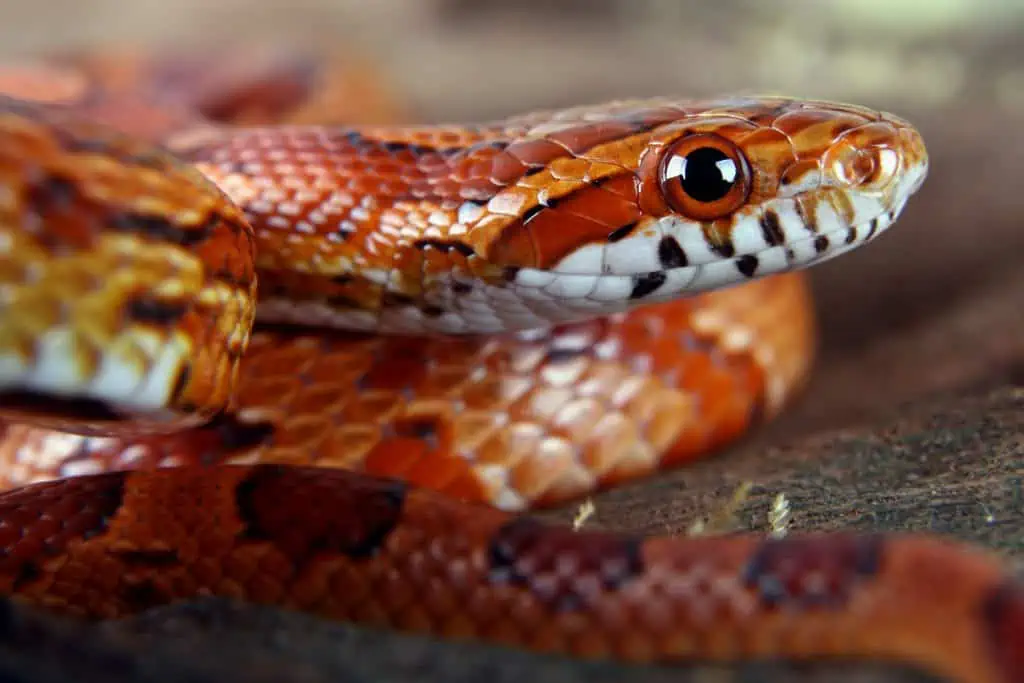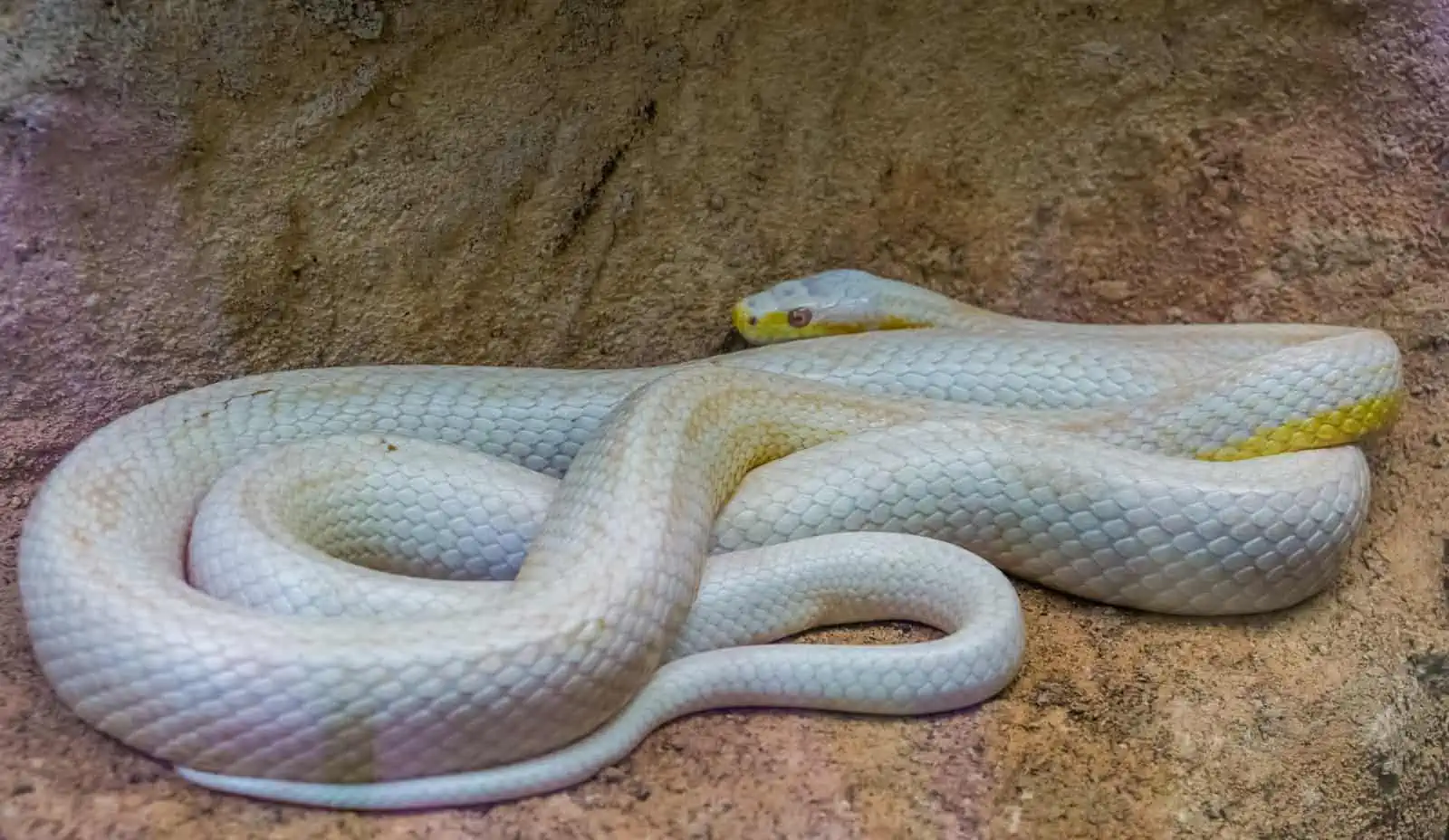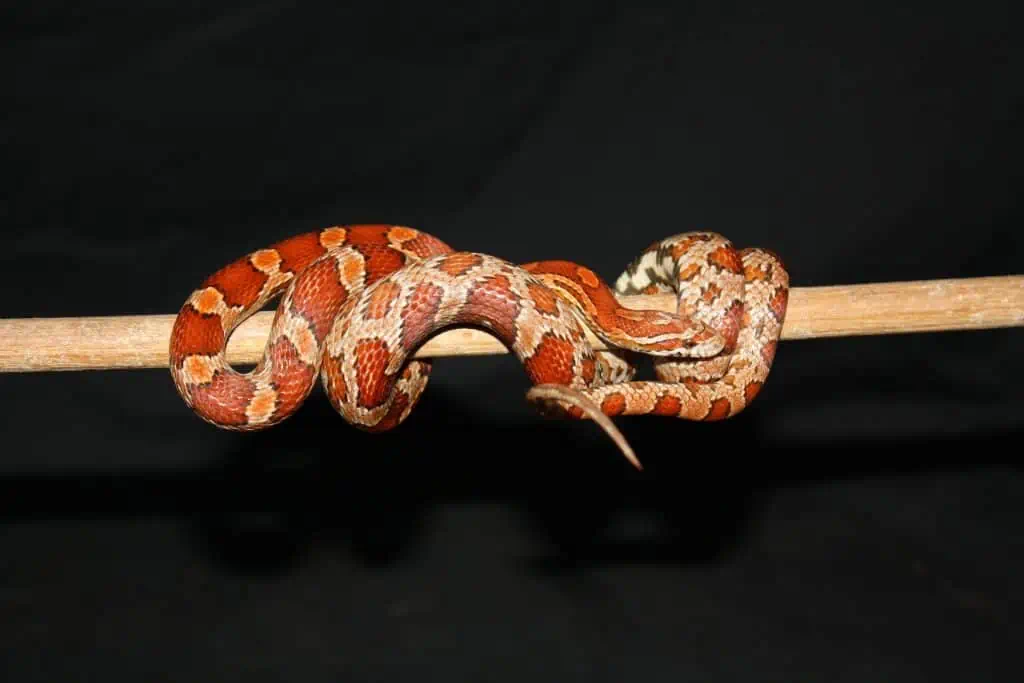Looking to switch from petting domesticated animals to reptiles? Corn snake will be best for you – you’ll absolutely love it. Its friendly temperament, impressive looks, & smaller size make it a great choice for beginners!
Not only is this reptile adorable – but it also plays an important role in nature by helping to keep rodents away from crops & preventing the spread of disease.
These reptile companions can grow up to 6 feet long & live for up to 15 years in captivity – with the right care, of course!
So, how much does it cost to get started owning a snake?
As a matter of fact, it’s hard for anyone to give an exact figure- as there are many factors to consider – from the initial price of the snake itself to monthly bills such as food & vet visits. The costs will vary according to the individual situation.
But I’m here to end your worries and provide the necessary information to estimate your expenses. So let’s get started.
Are Corn Snakes Cheap?
You may think that corn snakes are expensive – but in reality, they can actually be quite affordable! Even the rarest morphs won’t break the bank – with a few exceptions, of course!
So don’t let the price deter you from owning one of these amazing little creatures. They make great pets & you’ll be surprised at how much joy they can bring to your life.
What Is the Cost of Just a Corn Snake?
On average, a corn snake costs ~$50. The price you pay for a corn snake will depend on factors such as:
- The snake’s morph rarity
- Age
- Sex
Let’s take an example, A Tessera Corn Snake is priced at ~$250 & a Baby Blood Red Scaleless Corn Snake (more rare morph) can cost up to $500.
Below I’ve broken down the prices of corn snakes (in accordance with their rarity) to give you an idea of what to expect when looking to buy one:
| Corn Snake Morph | Average Price |
| Common Morph | $30 – $50 |
| Popular Morph | $80 – $700 |
| Rare Morph | More than $1000 |
When buying a corn snake – I’d advise investing in one from a reliable breeder rather than the cheap ones sold by big brand names.
The latter usually sells snakes of questionable health & another most important concern is their animal husbandry isn’t always up to standard. Alternatively, consider checking with reptile rescues or sanctuaries near you to see if corn snakes are available for adoption.
What Are Corn Snake Enclosure & Accessories Costs?
I’m sure you know it: a corn snake can’t just be thrown into an empty tank and expect to thrive. You need to carefully create an environment that will keep your slithery friend healthy and happy, which means you have to purchase some stuff.
No need to worry though — most of these items are one-time buys! All you need is to craft an enclosure as close to their natural habitat as possible— then they’ll thrive!
Here I’ve breakdown the costs related to tank setup and accessories.
Tank
It’s super critical you don’t cut corners when getting a tank for your corn snake. A 20-gallon enclosure is the minimum size recommended–don’t go any smaller. In fact, it’s usually better to err on the larger side than too small.
However, you can house hatchlings & juveniles in a 10-gallon tank till the time they grow up; then, you’ll need to change their enclosure according to their size.
Don’t forget; undersized can be really detrimental–even deadly–to your corn snake. So make sure you get the right size.
Your setup’s price will largely depend on the size of the tank. Let’s take a look at the different enclosure sizes and price tag side by side.
| Corn Snake Age | Terrarium size | Average Price |
| Hatchlings/juveniles | 10-gallon | ~$40-$50 |
| Pre-adult (1-year-old) | 20-gallon | ~$75-$100 |
| Adult/fully grown (2+ years old) | 40-gallon | Up to $300 |
Also, you’ll need to get a wire mesh screen (costs up to $38) for the top of the tank and some clips (price ranges $5-$8) to keep it in place. This’ll make sure your corn snake doesn’t escape–but it still lets air flow freely, which is really important!
Heating Source
Heating your scaly friend’s enclosure is a must – without it, they won’t be able to regulate their body temperature. Heat lamps & mats are the most common methods for heating an enclosure – as both provide good heat sources for part of the space.
Additionally, many reptile enthusiasts also use radiant heat panels for heating up their snake’s habitat.
However, remember that there’d only be one side heated so your buddy can regulate itself. You can position the heat lamps and mats – so they only heat a portion of the enclosure – this way, your reptile companion will be able to control their own temperature.
Sometimes, spot heating is not sufficient for keeping a corn snake warm & the entire room needs to be heated -it is true for those who live in cooler areas.
In such cases – a space heater can be used to heat up your pet’s habitat.
| Heating Source | Average Cost |
| Heat lamps | $18 |
| Heat mats | $15 |
| Space heater | $40-$50 |
| Radiant heat panels | $50-$100 |
Enclosure Lighting
I’m sure you are wondering about the optional lighting for your corn snake – and here’s the skinny on that. It is worth noting that snakes do not necessarily require constant exposure to light, despite common misconceptions.
Just like us humans, they have sleep cycles determined by daylight. So, if there’s natural light coming through a nearby window, your snake won’t need any supplemental lighting.
But, if you keep your corn snake in a room away from sunlight – you should provide artificial light like a UVB bulb for ~8-12 hours to simulate day and night.
A UVB bulb usually costs between $20 – 30$.
Thermometer / Hygrometer
You probably know the importance of maintaining the correct environmental conditions for your reptile’s enclosure. The temperature and humidity of your corn snake’s home must be consistent and within the healthy range. Below is given the range of these parameters to have a better understanding.
| Parameter | Healthy Range |
| Temperature | 75°F-82°F |
| Humidity | 40%-50% |
Deviating from this could bring negative health effects, which would harm your beloved pet.
Good news😊!
It’s simple and inexpensive to watch over these factors with a hygrometer-thermometer combo tool with a price ranging between $10 to $ 20$.
Water Bowl
As we all know, like all living things, corn snakes need to stay hydrated. That’s why it’s super important they have access to clean water at all times – no chlorine!
A lot of the water they need comes from their food, so it’s still a good idea to give them an extra source, with a water bowl.
Most owners opt for a more natural-looking rock dish. They’re not overly expensive – usually only ~$10 to $20 – but they do need to be cleaned and refilled regularly. Otherwise, bacteria can build up and make your corn snake unwell.
For an even cheaper solution, a basic plastic storage container would do the trick!
Hideaways
Corn snakes need hides in their enclosure to feel secure and at ease. I recommend you provide two hides – one dry and one humid – for the ideal corn snake enclosure.
- Dry hides are clean areas where corn snakes can hide.
- Humid hides serve the same purpose but are kept damp and humid. The extra humidity is especially helpful during shedding.
You’ve got two options–get a dedicated hide for your snake or DIY with rocks, plant pots, whatever! Even on the pricier side, it won’t cost more than $30. So it’s up to you — ready-made or custom? It’s your call.
Misting
Since corn snakes originate from humid regions, it’s important to provide them with moisture using either a misting bottle or an automatic misting system. Both methods are effective, but there is a significant difference in cost between them.
| Misting Method | Average Price |
| Misting bottle | ~$5 |
| Automatic misting system | $50 or more |
Plants, Rocks & Other Decor
No doubt – sprucing up your corn snake’s enclosure with accessories and decorations can turn it into a paradise! Giving your scaly friend an environment filled with natural-looking wood, rocks & plants to explore and climb on – this diversity will take the enclosure to another level.
You’d experiment with different combinations & have fun creating a unique habitat for your scaly best friend.
The structures will make your pet feel comfortable – as if they were at home & also encourage them to exercise & exhibit their natural behavior.
| Decor | Average Price |
| Plants | $5-20$ |
| Rocks | $15-30$ |
| Wood | $10-30$ |
Decorating your buddy’s enclosure shouldn’t cost you more than $100 in total.
What Do Corn Snake Consumables Cost?
Being a naive pet parent, it’s essential to be aware of the ongoing costs related to consumable products – these are the items that can either be used up or become spoiled over time.
I suggest all pet parents to investing in high-quality versions of such products – as they have essential functions within the snake’s enclosure.
Using subpar supplies may lead to various adverse health effects – so it’s best to avoid them.
Food
Do you know what your corn snake loves? Small rodents! That’s their main food source, and you’re in luck – most pet stores have live or frozen feeder rats. Sign up for emails from reptile-specializing websites since they often have sales on feeders – it’ll save time and money if you buy them in bulk instead of always heading to the pet store. Plus – no more live mice running around your house!
Based on the age of your pet, feeding schedule & type of prey for your pet, here is what you can expect to pay for your reptile friend every month.
| Snake Age | Feeding Schedule | Prey Type | Monthly Expenditure |
| Less than 6 months | Every 5-7 days | Pinky mouse | $1.6 – $2.4 |
| 1 – 2 years old | Every 7 days | Large mouse | $4.36 |
| 2 – 4 years old | Every 7-10 days | A small rat | $9 – $12 |
| More than 4 years old | Every 7-14 days | A small rat | $6 – $12 |
Substrate
To provide a comfortable and natural floor, absorb waste and control bad odors in a corn snake’s enclosure, a substrate is needed for your buddy’s habitat. There’re different types of substrate available, like:
So when choosing a substrate, ensure that it has the following:
- Good moisture retention properties
- Doesn’t mold quickly
- It’s made of safe &comfortable fibers
A high-quality substrate that’s entirely changed out about once every two months will only cost about $50 to $80 yearly. To help keep their substrate in top condition, giving it a spot-clean whenever you see waste from your corn snake will make it last longer.
Sphagnum Moss
Another essential part of a corn snake enclosure is Sphagnum moss, which can retain moisture without decomposing or rotting. It goes in its humid hide and sprinkles around the space – perfect for humidity control.
And you’ll only need to replace it every 4-6 weeks, meaning it won’t be too much of a strain on your budget – a bag usually ranges from $10-$20.
Bathing Costs
Giving your corn snake a warm bath is really beneficial! It’s also very affordable – all you need is:
- A big bowl for them to swim in;
- Some warm spring or filtered water
Taking care of your reptile friend by keeping them clean is essential – as they’re prone to bacteria & skin infections.
Plus, it makes sense to give them a bath every now and then – they poop every 1-2 weeks, and fecal matter can cause bacteria to spread.
For just $13, you can get a large bowl for bathing.
Maintaining the cleanliness of your corn can protect it from the following:
- Constipation
- Mites
- Reduce its shedding issues
Furthermore, you can also save yourself from diseases caused by salmonella – so that’s an added bonus!
Habitat Cleaning Costs
Cleaning the habitat is as essential as maintaining the hygiene of your scaly friend. To do this:
- Grab yourself a bucket, then add one cup of bleach to 1 gallon of water.
- Place the antiseptic-soaked items in a well-ventilated area and let them sit for 5-10 minutes to get them dry.
Want something more specific? Then you’d look for a herp-safe chemical cleaner – it can cost you ~$15 to $30.
If there is a narrow area of the cage that you need to access, you can use the following:
- Razor blades
- Putty knives
- Toothpicks
- Q-tips

How Much Does Corn Snake Vetenarian Care Cost?
Like all organisms, Corn snakes may face health issues at some point. No matter how much vigilant owner you’re – there certain health concerns that are not preventable.
Therefore, it is crucial to closely monitor your corn snake & identify any potential problems before they get worse.
Although the likelihood of your corn snake falling ill is low – it is still a possibility.
Unfortunately, veterinary care for your snake can be quite costly & unpredictable.
It can also be challenging to budget for due to the uncertainty of when your snake may require professional attention.
Nevertheless – here are the most common things you will need to pay.
Parasitic Disease Meds
You’d be cautious about what you put in your corn snake’s cage – parasites, mites & diseases can appear from the strangest sources. Bedding from a bad batch, for instance, can contain mites. Diseases, too, may arise out of nowhere.
So it’s best to stay vigilant & you’d make sure nothing untoward enters your pet’s home.
However, you’re in luck 🙂!
Sorting out these issues isn’t too difficult or expensive. Your biggest expense will be a visit to the reptile specialist – they can diagnose & prescribe treatment for your snake quickly and easily.
| Medical Care | Average Cost |
| Vet Visit | $50-$100 |
| Fecal Parasite Test | $10-$30 |
| Parasite Treatment | $15-$40 |
| X-Rays | $50-$150 |
| Antibiotics for Respiratory Infection | $50 |
Annual Checkups
Like all pet owners, I’m certain you also want the best for your reptile friend. So I recommend you take your pet for a complete medical checkup once a year with their vet. That way, if there’re any little issues, they can be dealt with quickly and save you from expensive emergency treatments.
A checkup is key to catching minor health problems before they escalate – costing you ~$50 – 100$ annually.
Emergencies
Handling your pet with a proper technique is the most important part of being a great pet parent However, if you happen to injure your buddy severely while holding or your pet has come across a very lethal disease due to improper habitat conditions, your vet may prescribe surgery to get your pet back on track – you’ll also need to stay at your vet’s clinic for an extended period of time.
This cost will be the most unpleasant one for you to deal with among all the expenses associated with owning a pet snake & it’s a hefty one ranging between $500 – 1000$.
🐍 Pro Tips:
There are 2 things that I would like all pet parents to do.
- Not all veterinarians deal with exotic animals, so beforehand, make sure to look for the veterinarians located nearest to your area.
- To prepare for unexpected veterinary expenses, I recommend you allocate $800-$1,200 for emergencies.
Money-Saving Tips
Keeping a snake as a pet can be more expensive than expected, but there are ways to reduce expenses. Here are some tips to save money:
- Rather than going to a store, get your snake from a breeder – it’s more cost-effective.
- If you have a snake that can chow down on pre-killed, frozen prey, try buying their food in bulk to save money. You’ll easily be able to cut costs in half or more this way!
- You can also get creative in case of hides for your buddy. This way, you don’t have to spend much money on commercial boxes; repurposing items like Rubbermaid containers or storage boxes can save you cash.
- You can get substrate for your scaly companion from home improvement & garden stores – these offer great deals on materials like pine bark, cypress mulch, orchid bark & more – way cheaper than pet stores.
To Sum It Up
So, there you have it – corn snakes can make great pets & I hope It’s clear to you now that owning a corn snake can be a fun and exciting experience, but there are some costs associated with taking care of them.
The purchase price alone is usually ~$30-$1000, but the cost of setting up your pet’s habitat, providing food & getting regular vet checkups for them will add to your overall expenses.
So I advise you to do your research and set a budget before welcoming your new buddy!
Is there anything else you’d like to add? How much do you think people should plan to spend annually on their pet corn snakes? Let us know in the comments!





One Comment
This information helped alot